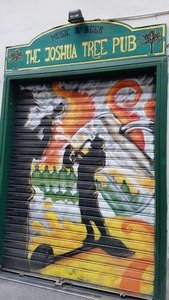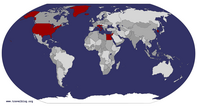Advertisement
Published: June 12th 2018

 Pub near our hotel in Florence
Pub near our hotel in Florence
I didn't get around to visiting.(I apologize for the delay in posting. I tried to post 3 days of events from Verona but the Internet was not cooperating at all. I couldn't upload photos and the Internet was on/off/on/off. I finally quit. So, I'm home now getting caught up.
)
Today we left beautiful but busy Florence. What I mean is that it is not easy to walk around Florence: narrow streets, people to dodge around, cars, scooters, motorcycles, buses, etc. Walking in a straight line is impossible. The walking exhausted me. Before we left Florence we had one last stop: The Academy Gallery where Michelangelo's original David is kept. Getting into the gallery was the typical hurry up and wait routine, and we only had time to see David- which is spectacular. There are also many unfinished sculptures by Michelangelo. I took lots of photos, and then we were on our way to Verona.
From Wikipedia:
The
Galleria dell'Accademia di Firenze, or "Gallery of the Academy of Florence", is an art museum in
Florence,
Italy. It is best known as the home of
Michelangelo's sculpture
David. It also has other sculptures by Michelangelo and a large collection of
paintings by Florentine artists, mostly from the period 1300-1600, the
Trecento to the Late Renaissance. It is smaller and more specialized than the
Uffizi, the main art museum in Florence. It adjoins the
Accademia di Belle Arti or academy of fine arts of Florence, but despite the name has no other connection with it.
In 2016 it had 1,461,185 visitors, making it the second most visited art museum in Italy, after the Uffizi (2.02 million).
We had trouble on the highway due to an overturned truck that was on fire. This made us late arriving in Verona so instead of checking into our hotel we went straight to the walking tour of Verona.
From Wikipedia:
Verona or
Veròna) is a city on the
Adige river in
Veneto,
Italy, with approximately 257,000 inhabitants and one of the seven provincial capitals of the region. It is the second largest city
municipality in the region and the third largest in
northeast Italy. The
metropolitan area of Verona covers an area of 1,426 km
2 (550.58 sq mi) and has a population of 714,274 inhabitants.
It is one of the main tourist destinations in northern Italy, owing to its
artistic heritage, several annual fairs, shows, and
operas, such as the lyrical season in the
Arena, the ancient
amphitheater built by the
Romans.
The
Arco dei Gavi (Gavi Arch) was built in the 1st century AD, and is famous for having the name of the builder (architect
Lucius Vitruvius Cordone) engraved on it, a rare case in the architecture of the epoque. It originally straddled the main
Roman road into the city, now the Corso Cavour. It was demolished by French troops in 1805 and rebuilt in 1932.
erona%!j(MISSING)pg/220px-Piazza_dei_Signori_%!V(MISSING)erona%!j(MISSING)pg)
Piazza dei Signori
 San Zeno Basilica
San Zeno Basilica, like many other Veronese churches, is built with alternating layers of white stone and bricks
erona%!j(MISSING)pg/220px-Piazza_delle_Erbe_-_Palazzo_Maffei_%!V(MISSING)erona%!j(MISSING)pg) Piazza delle Erbe
Piazza delle Erbe
The balcony of
Juliet's house

The Portoni della Bra
Nearby is the
Porta Borsari, an archway at the end of Corso Porta Borsari. This is the façade of a 3rd-century gate in the original Roman
city walls. The inscription is dated 245 AD and gives the city name as
Colonia Verona Augusta. Corso Porta Borsari, the road passing through the gate is the original
Via Sacra of the Roman city. Today, it is lined with several
Renaissance palazzi and the ancient
Church of Santi Apostoli, a few metres from Piazza delle Erbe.
Porta Leoni is the 1st century BC ruin of
what was once part of the Roman
city gate. A substantial portion is still standing as part of the wall of a medieval building. The street itself is an open
archaeological site, and the remains of the original Roman street and gateway foundations can be seen a few feet below the present street level. As can be seen from there, the gate contains a small court guarded by towers. Here, carriages and travelers were inspected before entering or leaving the city.
Verona is famous for its Roman
amphitheatre, the
Arena, found in the city's largest piazza, the
Piazza Bra. Completed around 30 AD, it is the third largest in Italy after Rome's
Colosseum and the arena at
Capua. It measures 139 metres long and 110 metres wide, and could seat some 25,000 spectators in its 44 tiers of marble seats. The
ludi (shows and
gladiator games) performed within its walls were so famous that they attracted spectators from far beyond the city. The current two-story
façade is actually the internal support for the tiers; only a fragment of the original outer perimeter wall in white and pink
limestone from
Valpolicella, with three stories remains.The interior is very impressive and is virtually intact,
and has remained in use even today for public events, fairs, theatre and open-aired
opera during warm summer nights.
The balcony of Juliet and the statue was a bit of a joke. There's no evidence that Shakespeare was even here, and the balcony is fake - made for tourists. After the walking tour we checked into our hotel. Nancy & I weren't really hungry so we walked around to try to find a place with a small meal. There wasn't anything in our immediate neighborhood so we split a Ceasar salad in the hotel restaurant. Tomorrow most of the group is going to Venice, but some of us are staying in Verona (me included since I had just come from Venice a week ago).
Advertisement
Tot: 0.153s; Tpl: 0.014s; cc: 8; qc: 41; dbt: 0.0618s; 1; m:domysql w:travelblog (10.17.0.13); sld: 1;
; mem: 1.2mb







erona%!j(MISSING)pg/220px-Piazza_dei_Signori_%!V(MISSING)erona%!j(MISSING)pg)

erona%!j(MISSING)pg/220px-Piazza_delle_Erbe_-_Palazzo_Maffei_%!V(MISSING)erona%!j(MISSING)pg)



















